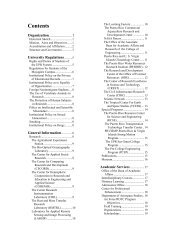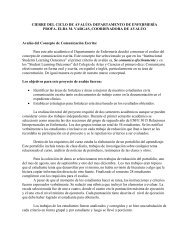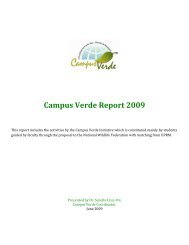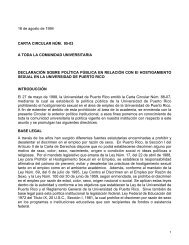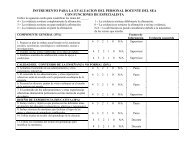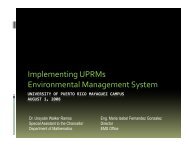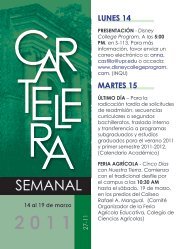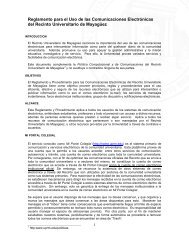parasites of offshore big game fishes of puerto rico - Uprm
parasites of offshore big game fishes of puerto rico - Uprm
parasites of offshore big game fishes of puerto rico - Uprm
You also want an ePaper? Increase the reach of your titles
YUMPU automatically turns print PDFs into web optimized ePapers that Google loves.
MONOGENEA (GILLWORMS)<br />
Tristomella lintoni (Price) - This species was reported from the gills <strong>of</strong> a<br />
skipjack tuna caught <strong>of</strong>f Woods Hole, Massachusetts, USA. It was described<br />
from a single immature specimen which was not in good condition (USNPC<br />
4878). Despite the occurrence <strong>of</strong> this worm and "Capsala laevis" in checklists<br />
<strong>of</strong> western Atlantic skipjack tuna, we find no valid records <strong>of</strong> capsalids on this<br />
fish in our area. The specimen described by Price (1960) was probably then<br />
result <strong>of</strong> accidental infection and its status must remain uncertain.<br />
Tristomella onchidiocotyle (Setti) - MacCallum collected an immature<br />
capsalid in the gills <strong>of</strong> a "Thunnus thunnus-horse mackerel" (=bluefin tuna)<br />
from Woods Hole, Massachusetts, USA (USNPC 35644). Price (1939) des-<br />
cribed this worm as a new species Capsala maccallumi, suggested that it was<br />
probably identical to C. onchidiocotyle, but listed the host as "little tunny" with-<br />
out explanation. The haptor <strong>of</strong> this worm extends beyond the body outline.<br />
Testes are numerous and extend beyond the field between the ceca. The anchors<br />
have a distinct hook on the end. It occurred on bluefin tuna in the Mediterranean<br />
and <strong>big</strong>eye tuna <strong>of</strong>f west Africa, probably on bluefin tuna <strong>of</strong>f the Atlantic coast<br />
<strong>of</strong> the USA and throughout the Atlantic. This parasite occurs on the gills and<br />
is 2.6 mm long. It is probably genus (Thunnus) and tribe specific. This worm<br />
needs to be redescribed and more collections are needed in the western Atlantic<br />
to resolve the mystery <strong>of</strong> its distribution.<br />
CESTODA (TAPEWORMS)<br />
Tapeworms or cestodes form a large class <strong>of</strong> the flatworms or<br />
platyhelminths. The common name comes from the long series <strong>of</strong> body<br />
segments which resemble a tape measure. Most adult tapeworms look like long,<br />
flat cooked noodles. Most larval forms look like the tiny pieces <strong>of</strong> noodle that<br />
stick in the colander. A giant, broad tapeworm that lives in the body cavity <strong>of</strong><br />
freshwater <strong>fishes</strong> in Europe is apparently routinely eaten by humans who mistake<br />
it for parts <strong>of</strong> the fish! Tapeworms can reduce growth and affect reproductive<br />
success <strong>of</strong> <strong>fishes</strong>. Some that infect humans occur as immature or larval forms<br />
in <strong>fishes</strong>. A small-boat fishery for tunas on the northwest coast <strong>of</strong> Puerto Rico<br />
was closed by the government because <strong>of</strong> reports <strong>of</strong> "wormy" flesh in these food<br />
<strong>fishes</strong>. When we were contacted to examine these <strong>parasites</strong>, we found that they<br />
were larval tapeworms, and recommended that the fishery be immediately<br />
reopened. We knew that previous experimental attempts to infect mammals with<br />
similar larvae failed because the <strong>parasites</strong> mature only in sharks and rays. The<br />
fishery was quickly reopened, averting major losses to local fishermen. We<br />
occasionally receive similar cases <strong>of</strong> wormy filets from individuals. People do<br />
not like seeing larval tapeworms moving around in the flesh <strong>of</strong> their fish, but<br />
those in Puerto Rican <strong>fishes</strong> are relatively harmless (particularly when cooked).<br />
More than 5000 species <strong>of</strong> tapeworms are known. Adults range from less<br />
than a millimeter to more than 30 meters in length. Tapeworms usually consist<br />
<strong>of</strong> a chain <strong>of</strong> segments (proglottids) each with a set <strong>of</strong> female and male<br />
103



